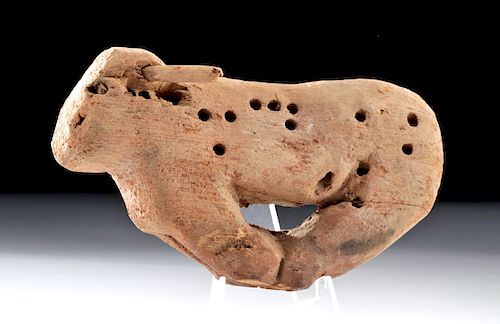Egyptian Wood Votive Figure - Trussed Ox
Lot 15a
About Seller
Artemis Gallery
686 S Taylor Ave, Ste 106
Louisville, CO 80027
United States
Selling antiquities, ancient and ethnographic art online since 1993, Artemis Gallery specializes in Classical Antiquities (Egyptian, Greek, Roman, Near Eastern), Asian, Pre-Columbian, African / Tribal / Oceanographic art. Our extensive inventory includes pottery, stone, metal, wood, glass and textil...Read more
Categories
Estimate:
$600 - $900
Absentee vs Live bid
Two ways to bid:
- Leave a max absentee bid and the platform will bid on your behalf up to your maximum bid during the live auction.
- Bid live during the auction and your bids will be submitted real-time to the auctioneer.
Bid Increments
| Price | Bid Increment |
|---|---|
| $0 | $25 |
| $300 | $50 |
| $1,000 | $100 |
| $2,000 | $250 |
| $5,000 | $500 |
| $10,000 | $1,000 |
| $20,000 | $2,500 |
| $50,000 | $5,000 |
| $100,000 | $10,000 |
| $200,000 | $20,000 |
About Auction
By Artemis Gallery
Dec 12, 2019
Set Reminder
2019-12-12 10:00:00
2019-12-12 10:00:00
America/New_York
Bidsquare
Bidsquare : Holiday Sale - Antiquities / Ethnographic Art
https://www.bidsquare.com/auctions/artemis-gallery/holiday-sale---antiquities-ethnographic-art-4743
What to give this holiday season? You'll find plenty of options in our Dec. 12 auction that will cater to all tastes and budgets. Artemis Gallery info@artemisgallery.com
What to give this holiday season? You'll find plenty of options in our Dec. 12 auction that will cater to all tastes and budgets. Artemis Gallery info@artemisgallery.com
- Lot Description
**Holiday Shipping Deadlines**
USA Domestic: 12/14 for Standard; 12/23 for Express; International: 12/7 for Standard; 12/19 for Express
Ancient Egypt, Third Intermediate to Late Dynastic Period, 21st to 31st Dynasty, ca. 1070 to 332 BCE. A hand-carved votive sculpture depicting a trussed ox with forelegs and hind legs bound together. The animal is defined by its bulbous body, wide snout, and powerful legs. The body has several drilled mortises that were perhaps used for depositing smaller offerings. Figures depicting bound oxen represent food and sustenance for a deceased individual during their journey through the afterlife. The survival of this ancient wooden sculpture suggests this was entombed with the deceased upon burial. Size: 4.1" L x 2.3" H (10.4 cm x 5.8 cm)
For a stylistically similar example of a trussed ox formed from glass, please see The Museum of Fine Arts, Boston, accession number 72.1296.
Provenance: private J.H. collection, Beaverton, Oregon, USA, acquired in 2016; ex-Helios Gallery, Wiltshire, England; ex-private Steinberg collection, Zurich, Switzerland, acquired in London during the 1960s to 1970s
All items legal to buy/sell under U.S. Statute covering cultural patrimony Code 2600, CHAPTER 14, and are guaranteed to be as described or your money back.
A Certificate of Authenticity will accompany all winning bids.
We ship worldwide and handle all shipping in-house for your convenience.
#151265Minor abrasions and fissures to body, legs, and head, with nicks to some carved areas, and light encrustations within some drilled holes. Great earthen deposits and nice patina throughout.Condition
- Shipping Info
-
All shipping is handled in-house for your convenience. Your invoice from Artemis Gallery will include shipping calculation instructions. If in doubt, please inquire BEFORE bidding for estimated shipping costs for individual items.
-
- Buyer's Premium



 EUR
EUR CAD
CAD AUD
AUD GBP
GBP MXN
MXN HKD
HKD CNY
CNY MYR
MYR SEK
SEK SGD
SGD CHF
CHF THB
THB














